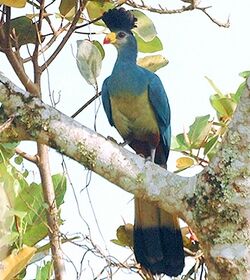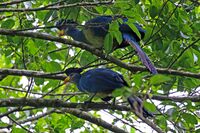Biology:Great blue turaco
| Great blue turaco | |
|---|---|

| |
| In Uganda | |
| File:Great Blue Turaco (Corythaeola cristata) (022A-WA03044X0043-0035M0).ogg | |
| Call recorded at Kakamega, Kenya | |
| Scientific classification | |
| Domain: | Eukaryota |
| Kingdom: | Animalia |
| Phylum: | Chordata |
| Class: | Aves |
| Order: | Musophagiformes |
| Family: | Musophagidae |
| Genus: | Corythaeola Heine, 1860 |
| Species: | C. cristata
|
| Binomial name | |
| Corythaeola cristata (Vieillot, 1816)
| |
The great blue turaco (Corythaeola cristata) is a bird species of the family Musophagidae. At 70–76 cm (28–30 in) in length, it is the largest species of turaco. It has predominantly grey-blue plumage with an upright blue-black crest around 10 cm (3.9 in) high. The male and female have similar plumage. It is widespread throughout the African tropical rainforest.
Taxonomy
French ornithologist Louis Vieillot described the great blue turaco as Musophaga cristata in 1816,[2] before German ornithologist Ferdinand Heine placed it in its own genus in 1860.
The great blue turaco is the sole member of the subfamily Corythaeolinae within the turaco family. Its closest relatives are the go-away birds and plantain eaters of the genus Crinifer. The common ancestor of both diverged from the ancestor of all other turaco species.[3]
"Great blue turaco" has been designated the official common name by the International Ornithologists' Union (IOC).[4] It is also called blue plantain eater.[5]
Description
Generally, the great blue turaco is 70–76 cm (28–30 in) in length with a mass of 800–1,231 g (1.764–2.714 lb).[6] The adult great blue turaco has predominantly gray-blue upperparts with an upright blue-black crest, white chin, yellow-green lower breast and yellow belly darkening to chestnut brown posteriorly. The undertail coverts are chestnut, and the undertail is black and yellowish. The yellow bill has an orange-red tip, the eyes are brown, and surrounded by a ring of black bare skin. The legs and feet are black with yellow soles. The sexes have similar plumage.[5]
Distribution and habitat
The species ranges from Guinea in the west, east across the sub-Saharan nations to the Imatong Mountains in South Sudan; it also occurs in Uganda, Tanzania and western Kenya, south to the Democratic Republic of Congo and Angola. It inhabits rainforests and gallery forests. It has also adapted to areas cleared by humans and can thrive in these areas.[5]
Behaviour
The great blue turaco is gregarious, with birds forming small troops of some six or seven individuals.[5]
Feeding
The great blue turaco eats leaves, flowers, as well as fruit of many plant species, including those of the genera Musanga, Cissus, Ficus (such as Ficus capensis) Polyalthia, Heisteria, Dacryodes, Pachypodanthium, Uapaca, Strombosia, Trichilia, Drypetes, Viscum, Beilschmiedia, Coelocaryon, Croton, and Pycnanthus. In Kenya, it has been recorded eating mitzeeri (Bridelia micrantha) in April, loquat (Eriobotrya japonica) in July, guava (Psidium guajava) in September and Cordia africana over November and December.[5] Fieldwork in Rwanda revealed leaves constituted around 25% of its diet, being eaten more often when fruit is less abundant.[7] The species also plays a role in seed dispersal as it generally passes seed in its feces some distance from parent trees.[8]
Breeding
The species nests in trees between 8 and 25 metres (26 and 82 ft) above the ground, and the nest is a platform of sticks. Both sexes incubate the clutch of two (rarely one or three) eggs over 29–31 days. The eggs are white or greenish white and almost round, measuring 46–50 mm by 41–43 mm (1.8–2.0 in by 1.6–1.7 in).[5]
Interactions with humans
Highly regarded as food in West Africa, it is often hunted and eaten by local people.[5] The BaMbala and related tribes around the town of Kikwit in the DRC, call the great blue turaco kolonvo. The meat is popular in smaller villages, and the long tail feathers are prized for decorations. The Mbuti people of the Ituri Rainforest in the Democratic Republic of the Congo consider the great blue turaco (which they call kulkoko) to be associated with okapis, which they would warn of danger by calling loudly.[9][10] They also believe that eating the species while pregnant may result in a difficult delivery or birth deformity. It is also a clan totem animal and as such, cannot be eaten by members of that clan; if they do eat it their teeth are said to fall out.[10]
References
- ↑ BirdLife International. (2017). Corythaeola cristata (amended version of 2016 assessment). The IUCN Red List of Threatened Species. doi:10.2305/IUCN.UK.2017-1.RLTS.T22688425A111660258.en
- ↑ Vieillot, Louis Jean Pierre (1816) (in fr). Analyse d'une Nouvelle Ornithologie Élémentaire. Paris: Deterville/self. p. 68. https://www.biodiversitylibrary.org/page/12830310.
- ↑ Perktaş, Utku; Groth, Jeff G.; Barrowclough, George F. (April 2020). "Phylogeography, Species Limits, Phylogeny, and Classification of the Turacos (Aves: Musophagidae) Based on Mitochondrial and Nuclear DNA Sequences". American Museum Novitates (3949): 1–61. doi:10.1206/3949.1.
- ↑ Gill, Frank; Donsker, David, eds (2021). "Turacos, bustards, cuckoos, mesites, sandgrouse". World Bird List Version 11.1. International Ornithologists' Union. https://www.worldbirdnames.org/new/bow/turacos/.
- ↑ 5.0 5.1 5.2 5.3 5.4 5.5 5.6 Fry, C. Hilary; Urban, Emil K.; Keith, Stuart (2020). The Birds of Africa; Volume III. Bloomsbury Publishing. pp. 27–28. ISBN 9781472986535. https://books.google.com/books?id=5yDsDwAAQBAJ&dq=Great+blue+turaco&pg=PA27.
- ↑ CRC Handbook of Avian Body Masses by John B. Dunning Jr. (Editor). CRC Press (1992), ISBN:978-0-8493-4258-5.
- ↑ Sun, Chin; Moermond, Timothy C. (1997). "Foraging Ecology of Three Sympatric Turacos in a Montane Forest in Rwanda". The Auk 114 (3): 396–404. doi:10.2307/4089241.
- ↑ Sun, Chin; Ives, Anthony R.; Kraeuter, Hans J.; Moermond, Timothy C. (1997). "Effectiveness of three turacos as seed dispersers in a tropical montane forest". Oecologia 112 (1): 94–103. doi:10.1007/s004420050288. PMID 28307381. Bibcode: 1997Oecol.112...94S.
- ↑ Terashima, Hideaki (November 2003). "The status of birds in the natural world of the Ituri forest hunter-gatherers". IRD Éditions. https://horizon.documentation.ird.fr/exl-doc/pleins_textes/divers16-08/010041920.pdf.
- ↑ 10.0 10.1 Ichikawa, Mitsuo (1998). "The Birds as Indicators of the Invisible World: Ethno-Ornithology of the Mbuti Hunter-Gatherers". African Study Monographs. Supplementary Issue 25: 105–121. doi:10.14989/68390. https://www.researchgate.net/publication/32171187.
External links
Wikidata ☰ Q847182 entry






